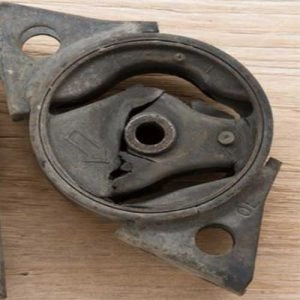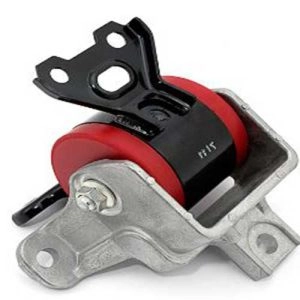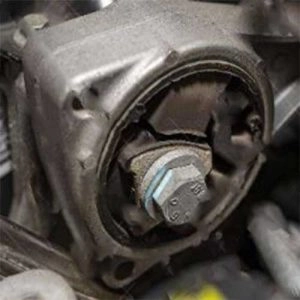Engine mounts, also known as "engine brackets", are small parts whose role is to connect the engine to the car structure. The engine produces significant vibrations when it is running, and consequently, the engine brackets work to reduce these vibrations and prevent any potential damage.
Usually, 2 or 3 or 4 mounts are used to connect the engine to the car's framework, which is typically made of metal and rubber. The metal is used to withstand the torque and power generated by the engine, and the rubber is used to absorb vibrations and shocks.
In addition, some engine mounts may contain fluids that help absorb and reduce vibrations resulting from the car engine's operation. In fact, engine mounts are considered the optimal solution for protecting the car from damage caused by vibrations.
Symptoms of Engine Mount Damage

Increased vibrations in the engine block can cause a lot of car parts to malfunction, increasing the amount of money, time, and effort spent. Here are the main symptoms that indicate engine mount damage:
Your text is only a single Arabic letter 'أ'. It has no specific meaning related to car maintenance and repair. Please provide a full sentence or paragraph for translation.Step One: Heavy Vibrations:
Excessive engine vibration is one of the most common signs of poor engine mounts, especially during acceleration and increased engine revolutions. In this case, the mounts work to stabilize and support the cars' engine when its movement is apparent. Damaged mounts lead to excessive engine movement, resulting in vibrations in the car's structure. Sometimes, these vibrations may even transfer to the car's cabin, thus enabling them to be clearly heard and felt.
At times, a driver may not notice these symptoms unless there is another person sitting in one of the passenger seats. The worst-case scenario would be the engine detaching from its mounts, indicating that the engine is at risk—it's unstable or misaligned. Consequently, the engine may start swaying left and right when the driver puts his foot on the accelerator for faster driving. It may also bounce up or down if you happen to drive over a bump, and this bounce will undoubtedly lead to engine damage.
So, if you feel a lot of vibrations while driving the car, it could be due to a malfunction in the engine mounts. Excessive vibrations can sometimes indicate a problem with the suspension system, tire alignment, or specific tire issues. Therefore, make sure to check the car at a maintenance center if you encounter such vibrations.
Also read: Three factors cause engine spark plug damage.
Secondly: The Strange Noises:
Damage to the engine mounts in your car is a common cause of the noise you may hear from the engine compartment. Typically, loud knocks and rattling are signs that the engine is moving freely at one or several points from the engine mounts, leading to the engine vibrating in an unusual way. It is also possible that it could collide with other nearby mechanical parts, causing it to emit strange rattling noises.
Generally, the sound of the engine is more noticeable during periods of reduced engine cycles. This is because the engine power in these cases is lower, allowing it to move back and forth. This can be extremely harmful if it continues for an extended period.
Finally, if you hear a louder noise than usual and feel noticeable vibrations when starting the car engine, this indicates that the engine mounts are damaged and you may need to replace them.
Thirdly: The movement of the car's engine:
Engine mounts help in positioning and correctly aligning the engine to run efficiently and competently. They contribute to improving the operation of all supporting mechanical parts under the hood. Some of the key signs of damage to the engine mounts in some cars are that the engine visibly moves when the gear stick is put in D or R position and both the brake and gas pedals are pressed together. Here, you might feel the engine move to the right or left, or forward or backward, during sudden acceleration or stopping, leading to severe damage to the unbalanced engine in this scenario.
What are the reasons that lead to engine mount damage?

Firstly: Incorrect installation
Engine mounts should be installed at a reliable maintenance center using the appropriate tools and equipment, as incorrect installation can lead to a breakdown of the mounts at a later time.
Secondly: The Manufacturing Defect
Although rare, the original engine mounts can quickly deteriorate in some cars. Therefore, it's important to check for any recalls related to engine mounts for your car through the Ministry of Commerce's "Recall" website.
Thirdly: The end of the useful life
Engine mounts are affected by constant pressure over time, thereby the rubber coating may lose its elasticity and eventually crack until it completely separates. Consequently, vibrations are transmitted to the car's driving cabin.
Fourth: Driving Style
Driving on rough roads and bumps, and sudden acceleration paired with hard stops multiple times, can significantly reduce the expected lifespan of the engine mounts.

Fifth: Accidents
It is essential to inspect the engine mounts after the car has been involved in any accident, as they can be noticeably affected and may even reach the point of breaking.
Sixth: Oil leakage on the engine seat.
Oil and fluid leaks are among the things that negatively affect the rubber casing of engine mounts, as they speed up its wear and tear. In addition, brake oil is considered very dangerous if it starts to leak.Engine bearingsBecause it leads to its damage in a short time.

Comments